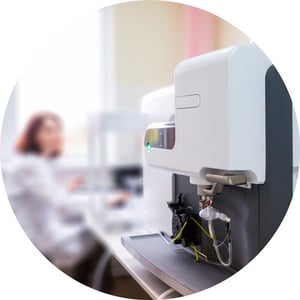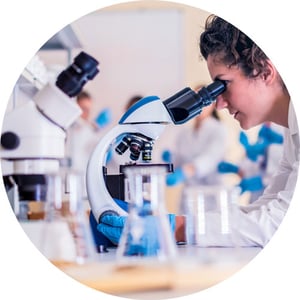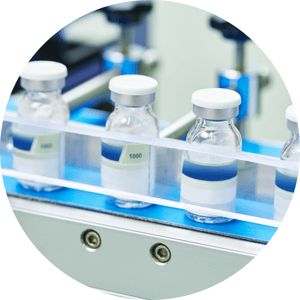
If you work in a laboratory, you know how important technology is for on-the-job success. Whether it's lab management software used to track and manage your research or technology that automates important steps in the experimental process, the right tools can give you an edge in terms of efficiency and accuracy.
To truly understand the fundamentals of a modern lab environment, it's worth taking a closer look at the key technologies used to get results. In this blog post, we'll be providing an overview of essential lab technologies.
Key Technologies
There are many technologies used in the lab, ranging from analytical tools to automation and robotics.
Analytical Instruments
The purpose of analytical instruments is to measure and analyze the properties of substances or materials to understand their composition, structure, or behavior.
They can measure various attributes, including chemical composition, physical properties (such as density, melting point, or refractive index), and structural properties (such as atomic and molecular structure). Here are some examples of instruments used for analytical purposes:
Spectrometers
A spectrometer is a tool that measures the properties of light, such as intensity, wavelength, and frequency, by breaking it down into its various parts. It is used to identify the chemical composition of a substance by analyzing the spectrum of light it absorbs or emits.
There are different types of spectrometers, including:
- Mass spectrometers
- Nuclear magnetic resonance spectrometers
- Optical spectrometers
Uses of spectrometers range from space exploration and characterization of proteins to respiratory gas analysis and monitoring dissolved oxygen in freshwater.
Chromatographs
Chromatography is a technique used to separate the components of a mixture based on their physical and chemical properties. It involves dividing the mixture into two phases, one stationary and the other moving, allowing the mixture's components to partition the two phases based on their affinity for each stage.
Titrators
Titrators are used to determine the concentration of a substance by measuring the volume of a reagent required to react with it. Titration is used to identify the presence or absence of specific substances in a mixture and determine the concentration of those substances. It enables scientists to understand the chemical makeup of a sample and can provide important information about the properties and behavior of the substances present.
X-Ray Diffractometers
An X-ray diffractometer is an instrument used to study a material's atomic and molecular structure. It works by firing a beam of X-rays at a sample and measuring the diffraction of the X-rays as they pass through the sample. The diffraction pattern produced can be used to determine the arrangement of atoms in the sample and identify the chemical bonds present.
Other analytical instruments include pH meters, refractometers, atomic absorption spectrophotometers, and infrared spectrophotometers.
Lab Software
Lab software is used to manage complex processes, from sample analyses to inventory management. Here are some of the most common software used in labs:
Electronic Lab Notebook (ELN)
An Electronic Lab Notebook (ELN) is a digital tool that replaces traditional paper notebooks used in research and development processes. It provides a more organized and efficient way to document and share experimental results and procedures. It also allows personnel to search, share, collaborate, and organize data.
Laboratory Information Management System (LMS)
A Laboratory Information Management System (LMS) is a software tool used to track and manage information related to samples and their analyses in a lab setting. It is often used in routine analytical labs to process and analyze samples.
An LMS can help to organize and track sample information and metadata. It uses several tools and technologies, such as barcode scanners, label printers, and integrations with other databases, to facilitate the transfer of data between systems.
Laboratory Data Management System (LDMS)
Like an LMS, a Laboratory Data Management System (LDMS) is used to track and manage information related to samples and their analyses. In addition to storing research data, an LDMS also stores relevant metadata, which makes the data searchable and easier to organize.
Other features of an LDMS may include access control, electronic signatures, audit trails, lifecycle management, and collaboration tools to enable sharing and working with others.
Process Analytical Technology (PAT) Software
Process Analytical Technology (PAT) is a software tool that helps to manage online control systems and adjust production parameters as needed to improve quality and efficiency. By using PAT, Biotech companies can more effectively monitor and control the production process, leading to higher-quality products and enhanced efficiency.
Other lab software includes Laboratory Execution Systems, Automation Scheduling Software, and Chromatography Data Management Systems.
 Microscopes and Imaging Equipment
Microscopes and Imaging Equipment
These are tools used to capture and analyze images of objects or samples. They include microscopes, scanners, cameras, and imaging software. Imaging equipment is often used in conjunction with microscopes to enhance the resolution and contrast of the captured images and allow for digital analysis and manipulation of the data.
Equipment applications include:
- Polymer science
- Materials science
- Engineering
- Forensics
- Environmental science
- Pharmaceuticals
- Semiconductors
Lab Automation and Robotics Instruments
Automation and robotics instruments are designed to serve a specific purpose, either by automating a task or helping a human technician or staff member complete a task more efficiently. Automation can be applied to a single step of an experimental process or automate the entire workflow from start to finish.
Automation improves efficiency and accuracy in the lab, reduces the risk of error, and increases the reproducibility of results. Types of lab automation include:
- Pre-analytical automation
- Analytical automation
- Post-analytical automation
The Benefits of Lab Technology
When it comes to scientific research, human error is inevitable. By implementing cutting-edge technologies, you can reduce these errors and increase efficiency in the lab. Data analysis and management software help scientists organize, analyze, and interpret data from experiments to improve the accuracy of results and make it easier to identify patterns and trends in the data. Meanwhile, robots automate repetitive and time-consuming tasks, freeing up scientists' valuable time to focus on complex experiments and analysis.
As technology advances, the benefits to labs will only continue to grow. For example, the increasing use of cloud-based solutions, remote monitoring, and virtual reality allows for remote access to lab data and equipment, increasing collaboration among researchers and making it more accessible for training.
With an array of technology at our disposal, we have greater control over our experiments and can uncover insights that were not available just a few short years ago. It is essential for those working in the field to take advantage of these advances to stay ahead of the competition and drive innovation forward.
Flagship Lab Services is a leading provider of specialized laboratory equipment and services in the Biotech industry. With a commitment to quality and innovation, we offer a range of products and solutions to support your research, development, and production needs.
For more information about our comprehensive lab support services, visit our lab services page.





Leave a Comment